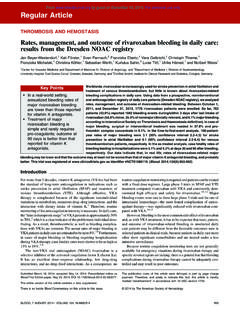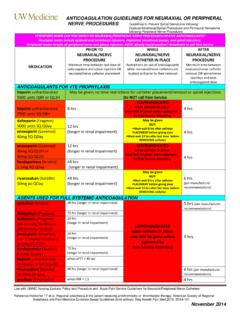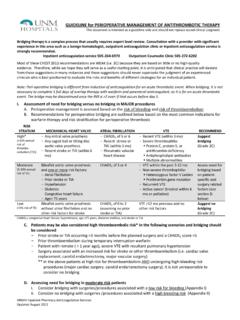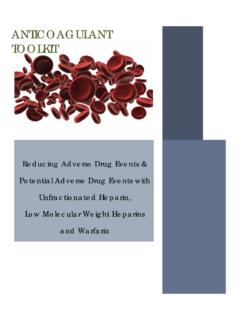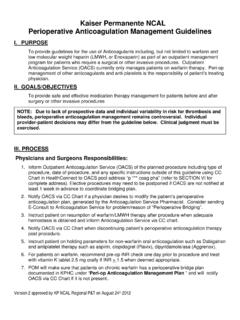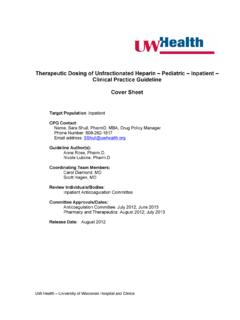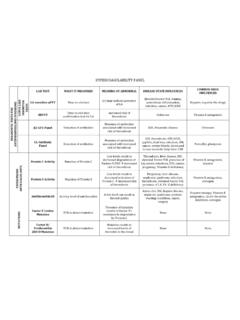Transcription of Efficacy and safety of early parenteral anticoagulation as ...
1 Blood Coagulation, Fibrinolysis and Cellular Haemostasis 1120. Efficacy and safety of early parenteral anticoagulation as a bridge to warfarin after mechanical valve replacement Joseph G. Mathew1; Alex C. Spyropoulos2; Arif Yusuf1; Jessica Vincent1; John Eikelboom1,7; Olga Shestakovska1; Stephen Fremes3;. Joseph Noora4; Linrui Guo5; Mark Peterson6; Menaka Pai7; Richard Whitlock1. 1 PopulationHealth Research Institute, McMaster University, Hamilton, Canada; 2 Hofstra, North Shore/LIJ School of Medicine, Manhasset, New York, USA; 3 Sunnybrook Health Sciences Centre, Toronto, Canada; 4 Trillium Health Centre, Mississauga, Canada; 5 London Health Sciences Centre, London, Canada; 6St.
2 Michael's Hospital, Toronto, Canada;. 7 Department of Medicine, McMaster University, Hamilton, Canada Summary ( %) who received prophylactic dose bridging experienced the pri- Limited evidence exists to guide the use of early parenteral anticoagu- mary Efficacy outcome (odds ratio [OR] ; 95 % confidence interval lation following mechanical heart valve replacement (MVR). The pur- [CI], to , p= ). Forty-eight patients ( %) in the thera- pose of this study was to compare the 30-day rates of thrombotic and peutic dosing group and 14 patients ( %) in the prophylactic dosing bleeding complications for MVR patients receiving therapeutic versus group experienced the primary safety outcome of major bleeding (OR.)
3 Prophylactic dose bridging regimens. In this retrospective cohort study ; 95 % CI, to ; p= ). The direction of the effects, their we reviewed anticoagulation management and outcomes of all pa- magnitude and significance were maintained in the propensity tients undergoing MVR at five Canadian hospitals between 2003 and matched analysis. In conclusion, we found that early after mechanical 2010. The primary Efficacy outcome was thromboembolism (stroke, valve replacement, therapeutic dose bridging was associated with a transient ischaemic attack, systemic embolism or valve thrombosis) similar risk of thromboembolic complications, but a to 3-fold in- and the primary safety outcome was major bleeding at 30-days.
4 Out- creased risk of major bleeding compared with prophylactic dose bridg- comes were compared using a logistic regression model adjusting for ing. propensity score and in a 1:1 propensity matched sample. A total of 1777 patients underwent mechanical valve replacement, of whom Keywords 923 received therapeutic dose bridging anticoagulation and 764 re- Cardiac surgery, valvular heart diseases, anticoagulants, heparin, ceived prophylactic dose bridging postoperatively. Sixteen patients thromboembolism ( %) who received therapeutic dose bridging and fifteen patients Correspondence to: Received: March 27, 2014.
5 Dr. Richard Whitlock, MD, PhD Accepted after major revision: June 24, 2014. David Braley Cardiac, Vascular & Stroke Research Institute Epub ahead of print: August 28, 2014. 237 Barton Street East, Room 1C1 114 Hamilton, Ontario, Canada, L8L 2X2 Thromb Haemost 2014; 112: 1120 1128. Tel.: +1 905 521 2100 40306. E-mail: Introduction UFH, low-dose low-molecular-weight heparin (LMWH) or thera- peutic dose LMWH over therapeutic dose UFH (Grade 2C evi- Patients with mechanical heart valves require lifelong anticoagu- dence) (4), while the 2008 American College of Cardiology/.
6 Lation with a vitamin K antagonist to prevent thromboembolic American Heart Association (ACC/AHA) guidelines make no rec- complications (1, 2). Warfarin treatment is usually initiated within ommendations regarding postoperative bridging anticoagulation 48 hours (h) of valve replacement surgery but takes 4 5 days to (5). Lack of consensus among the guidelines may contribute to reach therapeutic levels and during this time many cardiac sur- widely differing practices among cardiac surgery centres in the use geons bridge their patients with a rapidly acting parenteral antico- of bridging anticoagulation after mechanical valve replacement agulant.
7 Uncertainty remains about the benefits of parenteral (6). bridging anticoagulation after mechanical valve replacement sur- The purpose of this study was to describe the use of early post- gery as well as about the choice and intensity of the anticoagulant. operative bridging anticoagulation at Canadian cardiac surgery This uncertainty is highlighted by conflicting guideline recom- centres for patients undergoing mechanical valve replacement and mendations: the 2005 European Society of Cardiology (ESC) con- to compare the rates of thrombotic and bleeding events between sensus statement from the Valvular Heart Disease Working patients receiving standard therapeutic doses of bridging antico- Groups recommends bridging with therapeutic dose intravenous agulation and those receiving less intensive (prophylactic dose).
8 (IV) unfractionated heparin (UFH) (3), the 2012 American Col- bridging anticoagulation . lege of Chest Physician (ACCP) guidelines suggest use of low-dose Schattauer 2014 Thrombosis and Haemostasis Downloaded from on 2014-12-04 | ID: 1000472053 | IP: For personal or educational use only. No other uses without permission. All rights reserved. 1121 Mathew et al. Bridging anticoagulation after mechanical heart valve replacement Methods mary outcome as well as venous thromboembolism (VTE), defined as deep-vein thrombosis (DVT) or pulmonary embolism (PE) con- Design firmed by objective diagnostic testing, death, and length of stay.
9 The Five Canadian cardiac surgical centres participated in this study. primary safety outcome was major bleeding, defined as clinically Data were collected for every patient undergoing heart valve re- overt bleeding with the additional requirement of a drop in haemog- placement with a mechanical prosthesis from January 1, 2003 to lobin 20 g/l, or necessitating transfusion of 2 units of packed red December 31, 2010 at participating centres. The study was ap- blood cells (PRBCs), bleeding into a critical organ (intracranial, in- proved by the local research ethics board at each of the five partici- traspinal, intraocular, retroperitoneal, or intra-articular), surgical site pating centres.
10 Bleeding requiring re-operation or re-admission to the intensive care unit (ICU), and fatal bleeding. Only bleeding starting after the first dose of post-operative parenteral anticoagulation was recorded. Effi- Patients cacy and safety outcomes were collected up until hospital discharge Patients were eligible for this study if they were 18 years or older at or 30 days post valve replacement surgery, whichever came first. the time of mechanical valve replacement surgery. Patients with concomitant coronary artery bypass graft (CABG) and aortic pro- cedures were included.
